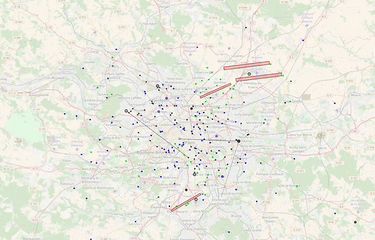A³, Airbus’ Silicon Valley innovation outpost, has launched Altiscope, a project to help define air traffic management (ATM) in a way that will allow the different types of flying vehicles to share airspace safely and efficiently.
By 2030, air traffic will increase more than tenfold as autonomous aircraft join existing traffic in the skies, according to Airbus’ internal estimates¹. Low-altitude delivery drones, autonomous urban air mobility (UAM) vehicles, high-altitude conventional planes, helicopters and other aircraft could all be in use above us. But in order for this to happen, decision-makers need tools to understand their regional airspace.
Altiscope is building a simulator to evaluate ATM policy options and operational models that can enable all forms of airborne traffic in a wide range of geographies and jurisdictions. In collaboration with partners around the world, Altiscope is safely enabling new uses of our airspace through deep analysis, policy simulation, and decision-modelling.
Developing safe and effective airspaces
One of the newest members of the team, former technologist at the Peace Innovation Lab at Stanford, Jessie Mooberry is the head of deployment for Altiscope. In this role, she works with global partners to build tight feedback loops and deploy products that support the mission of creating safe, effective airspaces. Mooberry says the A³ team is already working on discrete projects with a variety of global organisations across the public and private sector with engagements like risk modelling and operational analysis.
“For example, we might evaluate how urban air mobility vehicles, cargo drones, and commercial aircraft interact in the vicinity of shipping and logistics hubs. Our airspace is complex, and ensuring safety is at the forefront of regulators, operators, and manufacturers alike. Enabling missions like Vahana, CityAirbus, and Skyways will require quantitative and data-driven rulemaking demonstrating how these new missions will integrate safely into the airspace,” she says.


A new approach
Karthik Balakrishnan, who heads Altiscope, says that with the backing of Airbus and its worldwide resources, the project is being developed in an open ecosystem using a small internal team to partner with the best minds around the world. The bottom line is that current air traffic management systems are not equipped to manage that traffic, meaning that a fundamentally new approach is required.
“Creating the new order of the sky isn’t a new question and there are many parties working to solve the complexities of this pressing challenge. Altiscope brings a unique perspective to the table,” says Balakrishnan. “To start, we aren’t building an ATM system and we aren’t beholden to a specific policy, product or geography. Rather, Altiscope’s unique simulation framework is policy agnostic and globally relevant.”
“What exactly does that mean?” he continues. “Other ATM efforts are making tremendous strides in this space, typically focused on a given set of operation and mission goals. On the other hand, we are focused on evaluating different options for the new rules of the air and aren’t specifically tied to any particular ATM architecture. We aim to create a framework that accounts for any type of aircraft operation, system, aircraft platform, geography, and mission profile — without prioritising one kind over another.”
Successful future airborne traffic management depends on a solution that is both flexible and scalable as-yet-unimagined applications are developed and take flight.
